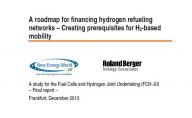Details
- Publication date
- 26 September 2014
- Author
- Fuel Cells and Hydrogen 2 Joint Undertaking
Description
Fuel cell electric vehicles (FCEVs) are zero tailpipe emission vehicles. Their large-scaledeployment is expected to play a major role in the de-carbonization of transportation in the European Union (EU), and is therefore an important policy element at EU and Member State level.
For FCEVs to be introduced to the market, a network of hydrogen refueling stations (HRS) first has to exist. From a technological point of view, FCEVs are ready for serial production already: Hyundaiand Toyota plan to introduce FCEVs into key markets from 2015, and Daimler, Ford and Nissanplan to launch mass-market FCEVs in 2017.
At the moment, raising funds for building the hydrogen refueling infrastructure appears to be challenging.
This study explores options for financing the HRS rollout which facilitate the involvement of privatelenders and investors. It presents a number of different financing options, involving public-sector bank loans, funding from private-sector strategic equity investors, commercial bank loans, privateequity, and funding from infrastructure investors. The options outline the various requirements forn accessing these sources of funding with regard to project structure, incentives and risk mitigation. The financing options were developed on the basis of discussions with stakeholders in the HRS rollout from industry and with financiers.
This study was prepared by Roland Berger in close contact with European Investment banks and a series of private banks.
This study explores in details the business cases for HRS in Germany and UK. The conclusion can be easily extrapolate to other countries.
To consult the full report
Readers interested in estimating what a HRS network would look like in other EU countries are invited to use the attached simulator
12 March 2014: Study on development of water electrolysis in the EU Final Report

